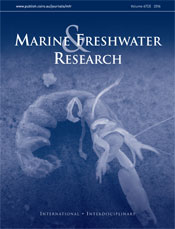Marine and Freshwater Research
Volume 67
Number 3 2016
Humans are affecting how plants and animals move among their ecosystems. We reviewed studies that have analysed how humans affect the movement of plants and animals among river, lake and ocean habitats. Our review reveals that a wide range of human activities sometimes can similar effects on plant and animal movement, which suggests there are some common strategies managers can use to conserve plants and animals.
Larval settlement and metamorphosis of many decapod species are triggered by physicochemical cues from the parental estuarine habitat. Here, we investigated whether the burrowing ghost shrimp (Lepidophthalmus siriboia) megalopae are stimulated by substrata and chemical cues from conspecific adults. Megalopal settlement and burrowing behaviour were induced by substrata, whereas metamorphosis to juvenile occurred irrespective of the presence or type of exogenous cues. Furthermore, megalopae developed significantly faster in the absence than the presence of substrata or conspecific stimuli. The independence of metamorphosis-stimulating cues shows important for colonisation and recovery of exploited callianassid populations.
Chemicals usually appear in the environment as mixtures. The aim of the present study was to assess nickel and zinc toxicity to Mysidopsis juniae and evaluate if their joint effects could be predicted by their single toxicity. Nickel showed to be more toxic than zinc and their mixture an additivity pattern. The present study highlights the need to assess combined effects in environmental scenarios.
Riparian tetragnathid spiders are important components of river–riparian food webs. We assessed the influence of riparian habitat and emergent aquatic insects on tetragnathids along the Scioto River, OH, USA. We show that nearshore physical and biological characteristics can lead to alterations in tetragnathid distribution and trophic dynamics and their capacity to serve as a functional linkage between aquatic and terrestrial ecosystems.
This is the first in situ seasonal study to investigate how freshwater autotrophic picoplankton responses to CO2 changes. CO2 elevation could significantly increase the abundance of photosynthetic picoeukaryotes in all seasons except winter, but did not have any influence on picocyanobacterial abundance. This might cause a reduction of the transfer of matter and energy to higher trophic levels and an increase the importance of the microbial food web under high CO2 levels.
Runoff from an extreme storm led to the formation of a pronounced halocline and underlying hypoxia in the upper reaches of the microtidal Swan–Canning Estuary. The survival of annelids and loss of crustaceans during this time reflects the different sensitivities of these taxa. The results emphasise that microtidal estuaries are highly vulnerable to the effects of environmental perturbations.
Acoustic surveys can estimate the biomass of marine fishes, but need to account for turnover of fish during the spawning season. A model is developed that estimates turnover based on changes in age, size and sex during the season. It can estimate the average proportion of the spawning biomass on the spawning grounds at any point in time.
We provide first demographic parameters for endangered Mediterranean subpopulation of spiny dogfish, a commercially exploited mesopredatory shark, highly sensitive to overfishing. Our results, coming from the eastern Mediterranean basin (Adriatic Sea), suggest that the species exhibits extreme life history traits with low growth coefficients, very late sexual maturity and long life span, which intensify its vulnerability to overexploitation. This study provides critical data necessary to develop efficient, species-specific conservation strategy for the spiny dogfish in the region.
Rice field and wetland macroinvertebrate beta diversity was compared at multiple spatial scales. In wetlands, hydrographic basin scale contributed the most to γ diversity. In rice fields, local different management practices were more important to diversity, which tends to homogenisation at broader scales. At least under drought climate conditions (ENSO phenomenon), only a small fraction of wetland community, mainly active dispersal taxa, was capable of colonising rice fields.
Molecular methods are gaining recognition as an improved approach to identify freshwater macroinvertebrates for research and monitoring programs, but are not applied widely in Australia. We applied DNA barcoding to specimens collected as part of monitoring programs and found that barcode data gave considerable informational benefit on macroinvertebrates. However, a lack of available sequence data for Australian freshwater fauna limited the scope of interpretation.




